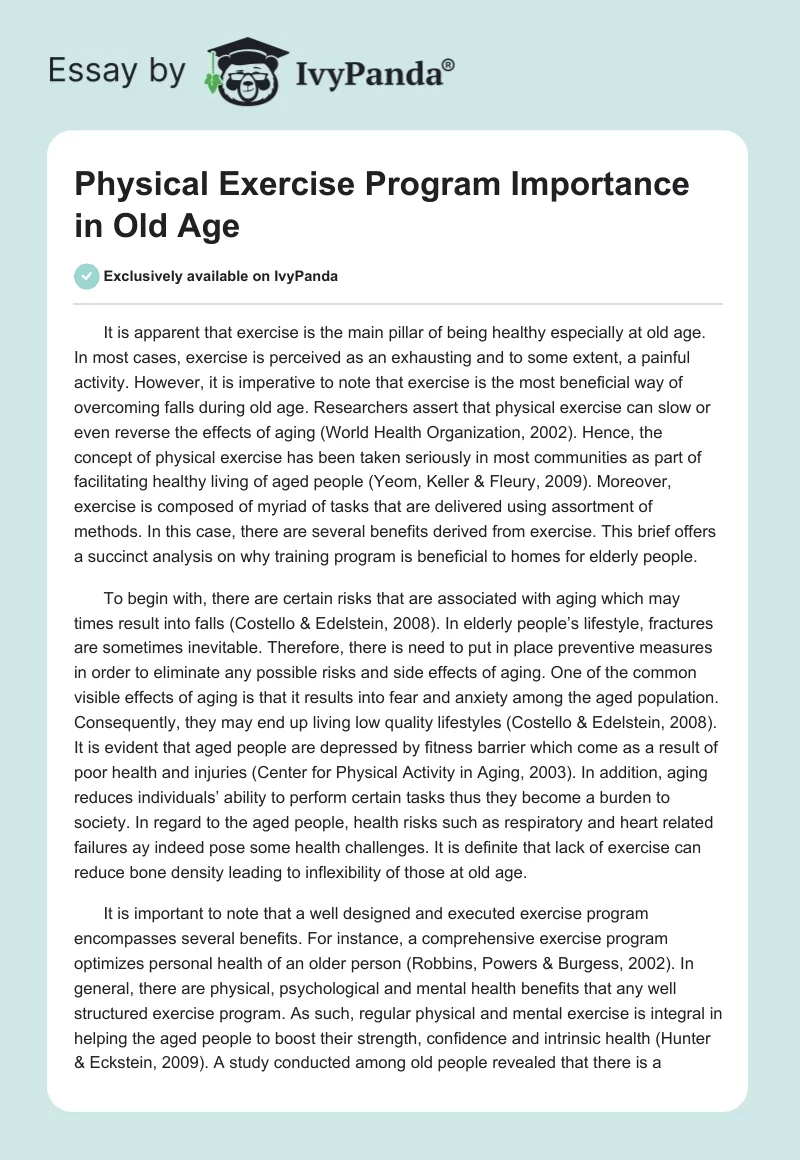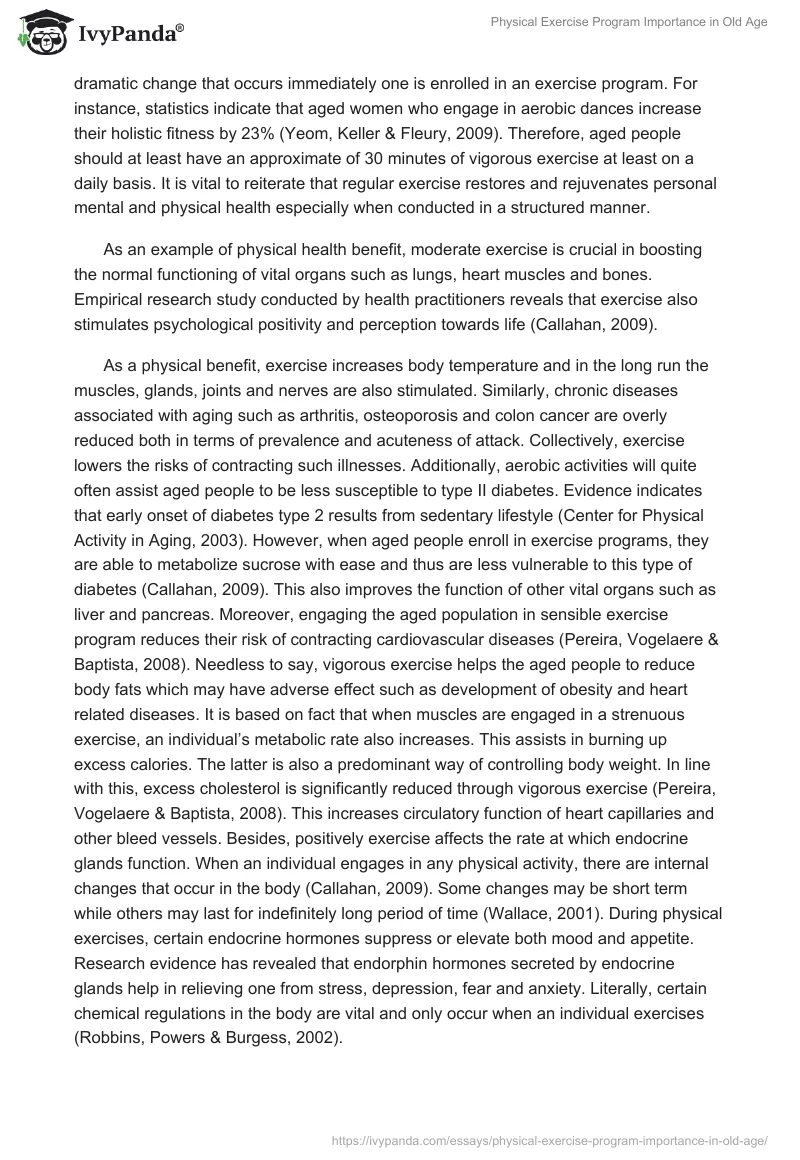It is apparent that exercise is the main pillar of being healthy especially at old age. In most cases, exercise is perceived as an exhausting and to some extent, a painful activity. However, it is imperative to note that exercise is the most beneficial way of overcoming falls during old age. Researchers assert that physical exercise can slow or even reverse the effects of aging (World Health Organization, 2002). Hence, the concept of physical exercise has been taken seriously in most communities as part of facilitating healthy living of aged people (Yeom, Keller & Fleury, 2009). Moreover, exercise is composed of myriad of tasks that are delivered using assortment of methods. In this case, there are several benefits derived from exercise. This brief offers a succinct analysis on why training program is beneficial to homes for elderly people.
To begin with, there are certain risks that are associated with aging which may times result into falls (Costello & Edelstein, 2008). In elderly people’s lifestyle, fractures are sometimes inevitable. Therefore, there is need to put in place preventive measures in order to eliminate any possible risks and side effects of aging. One of the common visible effects of aging is that it results into fear and anxiety among the aged population. Consequently, they may end up living low quality lifestyles (Costello & Edelstein, 2008). It is evident that aged people are depressed by fitness barrier which come as a result of poor health and injuries (Center for Physical Activity in Aging, 2003). In addition, aging reduces individuals’ ability to perform certain tasks thus they become a burden to society. In regard to the aged people, health risks such as respiratory and heart related failures ay indeed pose some health challenges. It is definite that lack of exercise can reduce bone density leading to inflexibility of those at old age.
It is important to note that a well designed and executed exercise program encompasses several benefits. For instance, a comprehensive exercise program optimizes personal health of an older person (Robbins, Powers & Burgess, 2002). In general, there are physical, psychological and mental health benefits that any well structured exercise program. As such, regular physical and mental exercise is integral in helping the aged people to boost their strength, confidence and intrinsic health (Hunter & Eckstein, 2009). A study conducted among old people revealed that there is a dramatic change that occurs immediately one is enrolled in an exercise program. For instance, statistics indicate that aged women who engage in aerobic dances increase their holistic fitness by 23% (Yeom, Keller & Fleury, 2009). Therefore, aged people should at least have an approximate of 30 minutes of vigorous exercise at least on a daily basis. It is vital to reiterate that regular exercise restores and rejuvenates personal mental and physical health especially when conducted in a structured manner.
As an example of physical health benefit, moderate exercise is crucial in boosting the normal functioning of vital organs such as lungs, heart muscles and bones. Empirical research study conducted by health practitioners reveals that exercise also stimulates psychological positivity and perception towards life (Callahan, 2009).
As a physical benefit, exercise increases body temperature and in the long run the muscles, glands, joints and nerves are also stimulated. Similarly, chronic diseases associated with aging such as arthritis, osteoporosis and colon cancer are overly reduced both in terms of prevalence and acuteness of attack. Collectively, exercise lowers the risks of contracting such illnesses. Additionally, aerobic activities will quite often assist aged people to be less susceptible to type II diabetes. Evidence indicates that early onset of diabetes type 2 results from sedentary lifestyle (Center for Physical Activity in Aging, 2003).
However, when aged people enroll in exercise programs, they are able to metabolize sucrose with ease and thus are less vulnerable to this type of diabetes (Callahan, 2009). This also improves the function of other vital organs such as liver and pancreas. Moreover, engaging the aged population in sensible exercise program reduces their risk of contracting cardiovascular diseases (Pereira, Vogelaere & Baptista, 2008). Needless to say, vigorous exercise helps the aged people to reduce body fats which may have adverse effect such as development of obesity and heart related diseases. It is based on fact that when muscles are engaged in a strenuous exercise, an individual’s metabolic rate also increases. This assists in burning up excess calories. The latter is also a predominant way of controlling body weight. In line with this, excess cholesterol is significantly reduced through vigorous exercise (Pereira, Vogelaere & Baptista, 2008).
This increases circulatory function of heart capillaries and other bleed vessels. Besides, positively exercise affects the rate at which endocrine glands function. When an individual engages in any physical activity, there are internal changes that occur in the body (Callahan, 2009). Some changes may be short term while others may last for indefinitely long period of time (Wallace, 2001). During physical exercises, certain endocrine hormones suppress or elevate both mood and appetite. Research evidence has revealed that endorphin hormones secreted by endocrine glands help in relieving one from stress, depression, fear and anxiety. Literally, certain chemical regulations in the body are vital and only occur when an individual exercises (Robbins, Powers & Burgess, 2002).
There are favorable aspects of mental health that results from exercise and they are definitely beneficial to aged people. For instance, during aerobic exercise, nerves in the body are stimulated and their interactions become coordinated and more effective (Corbin, Lindsey & Welk, 2000). In this case, exercise increases alertness and agility in the brain. This implies that exercise is vital in the sense that it boosts functional nature of the memory. Medical researchers confirm that exercise increases blood flow through capillaries right inside the brains. This accelerates supply of oxygen and glucose that enhances neuron function need to retain memory and relaying of information (Wallace, 2001).
In any older people’s homes, it is recommended that a comprehensive exercise program to be put in place as part and parcel of taking care of both their psychological and physical needs. For example, exercise augments mobility during old age. In this respect, their flexibility and posture is enhanced. In most cases, the later is beneficial in the sense that it initiates balance and coordination (Costello & Edelstein, 2008).
Furthermore, the fact that older people require adequate rest does not refute why sufficient sleep is necessary for this group of people. It is important to note that exercise improves quality of sleep. Aged people may experience sleeping difficulties due to age advancement and in turn affect their overall health (Corbin, Lindsey& Welk, 2000). In this essence, quality sleep alleviates one from health challenges such as depression and anxiety. When older adults exercise, their metabolism tends to hasten the rate at which they fall asleep. In addition, exercise programs ensure that aged people segregate a proportion of their time amid their other activities fro exercise. Nevertheless, it is worth to note that in order to achieve positive outcome, any form of exercise adopted in an elderly home should be regular and tailored towards the needs of specific group (Hunter & Eckstein, 2009).
Meanwhile, before subjecting the aged people into exercise programs, it is always advisable to assess their level of fitness. This ensures that nursing home directors are able to design fitness programs for them (Pereira, Vogelaere & Baptista, 2008). Moreover, this will also act as useful guide to health assistants when assembling relevant equipment for exercise programs. Meanwhile, the initial stage of exercises should be gradual since vigorous activity might breakdown body system especially if the old persons have not been subjected to physically engaging exercise programs for a long time. As such, nursing directors should allow the aged people to have free will in choosing which form of activity they want to involve themselves in (Corbin, Lindsey& Welk, 2000).
To recap it all, a modified exercise program enhances physical and mental fitness among old people. Comprehensive and well structured exercise program is indeed beneficial to aged adults since it is a way of increasing their physical fitness, reducing vulnerability to psychological complications alongside boosting self esteem.
References
Callahan, F. (2009). Physical activity programs for chronic arthritis. Current Opinion in Rheumatology. 21(2): 177-182.
Center for Physical Activity in Aging (2003). The benefit of exercise. Web.
Corbin, B., Lindsey, R. & Welk, G. (2000). Concepts of Physical Fitness and Wellness: A Comprehensive Lifestyle Approach. Boston: McGraw-Hill.
Costello, E. & Edelstein,E. (2008). Update on falls prevention for community-dwelling older adults. Review of single and multifactorial intervention programs. 45 (8): 1135-52.
Hunter, J. & Eckstein, F. (2009). Exercise and osteoarthritis. J Anat. 214 (2): 197-207.
Pereira, C., Vogelaere, P & Baptista, F.. (2008). Role of physical activity in the prevention of falls and their consequences in the elderly. European Review of Aging and Physical Activity. 5 (1): 51-58.
Robbins, G.,Powers, D. & Burgess, S.. (2002). A Wellness Way of Life. Boston: McGraw-Hill.
Wallace, P. (2001). “Health Benefits of Exercise and Fitness.” In Foundations of Exercise Science. Philadelphia: Williams & Wilkins publishing, Inc.
World Health Organization (2002). Active ageing: A policy framework. Web.
Yeom, A., Keller C. & Fleury J. (2009). Interventions for promoting mobility in community-dwelling older adults. J Am Acad Nurse Pract. 21(2): 95-100.


